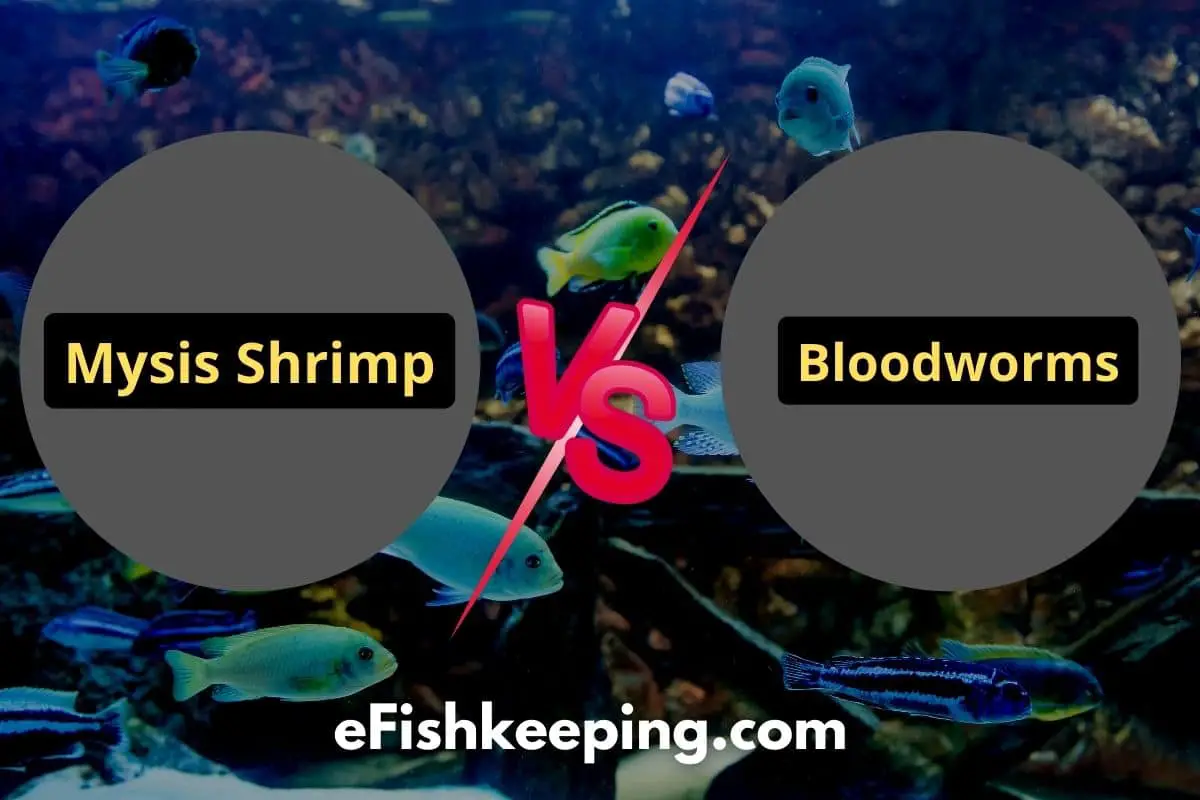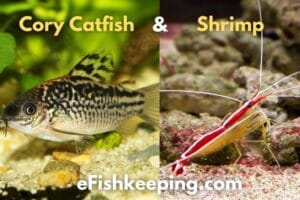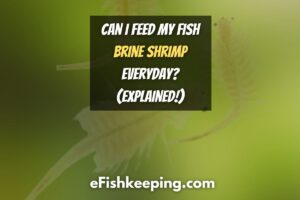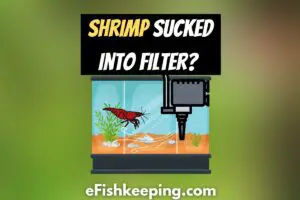Mysis shrimp and bloodworms both make great supplements to your pellet or flake diet and provide protein and amino acids to help your fish thrive. You might wonder what exactly the differences are when it comes to Mysis shrimp vs. bloodworms.
Mysis shrimps are small crustaceans similar to shrimp that are a great source of protein and essential fatty acids vital to fish. Bloodworms are the larvae of a non-biting fly called Chironomidae and are not true worms. Bloodworms contain protein and iron and are highly palatable to fish.
A varied diet is always best for your fish and gives them a more well-rounded nutritional profile. If you seek a supplement for your fish’s diet, both the Mysis and the bloodworm are excellent options.
Read on to discover what these two super fish foods are and which one is the best to feed your fish.
What are Mysis Shrimp?
Mysis shrimp are small crustaceans belonging to the order Mysidae and are shrimp-like omnivores of the superorder Peacardia. Although they are called shrimp, they are not true shrimp from the superorder Eucarida, although they share similar morphologies and behaviors.
Mysis shrimp are omnivorous scavengers and use filter-feeding to eat their diet of algae, detritus, and zooplankton. Mysis shrimp use appendages on their jaws called gnathopods to feed on zooplankton, strain the water for debris particles, and move the food under their jaws.
Although all Myisdae stem from marine environments, You can find the Mysidae throughout the globe, from shallow and deep marine waters to fresh and brackish water ecosystems.
They are found mainly in the coastal zones of the Arctic and high boreal seas, and taxonomists recognize fifteen species of Mysis shrimp.
These tiny crustaceans are sometimes called “opossum shrimp” because the female carries her young in a kangaroo-like brood pouch, and the Mysis larvae do not swim freely.
Mysis shrimp are remarkably adaptive to changing environments, although experts consider them a glacial relic dating back to the Famennian age 372-358 million years ago.
Mysis Shrimp Description
Mysis shrimp are often glassy and transparent, and you may only observe their black eyes in your aquarium tank. The adult body length is typically between 1 to 3 centimeters (0.4 to 1.2 in) with a characteristic pair of stalked eyes with two pairs of antennae.
They have a carapace of shield-like cover covering the head region and most of the thorax and eight pairs of limbs, each divided into two branches.
The female shrimp has a pouch made up of several brood plates where she keeps her young until they reach the juvenile stage. Mysis have a pair of appendages at the end of their body called uropods which give them their signature tail fan.
Mysis Shrimp Behavior and Reproduction
Mysis shrimp alternate between benthic (bottom-dwelling) and pelagic (midwater) behaviors and often crawl close to the substrate by day and rise to the upper water levels during the night.
The shrimp are omnivorous and feed on algae, waste, and zooplankton, and are prone to cannibalism of their young. When food is scarce, adult Mysis shrimp may even feed on each other.
Mysida reach sexual maturity between 12-20 days, depending on their body length and external environment. They mate by external fertilization, and the male boasts two long penises while the female sex organs are located in their brood pouch.
Mysidae mate at night for only a few seconds when the male inserts his penises in the female brood pouch and releases semen.
Female Mysis shrimp give birth to small batches of young at around 6-7 brood, but their short brooding time means they can produce a new batch of fry every 4-7 days.
What Are Bloodworms?
The term bloodworms describe both the larvae of the Chironomidae fly and the aquatic worm called Glycera dibranchiate. The more common bloodworm in commercial fish food and pet stores is the fly larvae and not the venomous aquatic worm Glycera.
Much confusion abounds online between two types of bloodworms, both of which can be viable food sources for freshwater and marine fish. The far more common origin of frozen or dried bloodworms is the larvae of the non-biting midge called Chironomidae.
The more scary Glycera dibranchiate are large, aquatic worms harvested from marine areas that deliver a nasty bite. These are worms proper and can grow to 35cms long and even have copper alloys in their adult jaws to catalyze their venomous bite.
These worms are more popular as live bait for angling and fishing, although they may also be used to feed aquaria fish. Glycera bloodworms are notoriously finicky to breed in captivity, so most of the species are harvested from their natural habitat in the mudflats of Maine, such as Bloodworm Depot.
As the midge fly larvae are by far the most common aquarium feed, I will discuss the Chironomidae.
What Are Midge Fly Larvae Bloodworms
The non-biting Chironomidae fly goes by many names from ‘ lake fly,’ ‘muffleheads,’ or ‘American soldiers,’ depending on where you live. From the family of nematoceran flies, they are found all around the world.
Although they resemble mosquitoes, they do not suck blood as they lack the elongated mouthparts and wings scales of the true mosquito family Culicidae.
The larvae of the midge are evident almost everywhere on the globe in aquatic or semi-aquatic habitats, including plants, tree holes, soil, and sewage.
Description and Behavior
The Chironomidae midge belongs to the same morphological group as mosquitos, so they look very similar in size and shape. They have long antenna-like mosquitos, but their mouthparts do not reach their mosquito cousins’ length.
The bloodworm larvae length rarely exceeds ¼ inch in size, and they are a thin, cylindrical shape with slightly curved segmented bodies and a distinctly separate head.
Bloodworm larvae spend most of their lives at pond bottoms or shallow bodies of water, where they eat a variety of organic materials as scavengers or filter feeders.
Most of these order of midges spend most of their life at the larval stage scavenging food for 1-3 years.
Adult midges only last a few weeks where they typically form swarms that dance in the air above water or objects (and even people!)
Midge Reproduction
As the adult stage of the bloodworm midges is short, the mate en mass, and the females lay a mass of eggs in a gelatinous nutritional coating on the water surface or adjacent vegetation.
These egg masses are typically laid in clutches of 20-30 eggs, although some lay up to 3000 eggs. The eggs sink through the water, where they hatch in about a week.
Bloodworms VS. Mysis Shrimp Advantages
- Bloodworms are highly palatable. Most aquarium fish will enjoy bloodworms, even the more picky feeders, as they are a more natural food source than pellets or flakes.
- High in iron and easy to digest. Unlike Mysis shrimp, the bloodworm does not have a carapace and is easily digested by aquarium fish.
- High in iron and protein. Bloodworms are nutritious and provide more iron than Mysis shrimp. Iron is essential in fish for the transport and storage of oxygen.
- Bloodworms have less fat than Mysis shrimp. Higher fat contents in shrimp may promote obesity or weight gain in fish,
Mysis Shrimp Vs. Bloodworms Advantages
- Shrimp have higher levels of HUFAs than bloodworms. Highly Unsaturated Fatty Acids are essential to a fish diet as they cannot make these fatty acids themselves. HUFAs are essential to fish as it provides a primary aerobic fuel source for energy metabolism.
- Mysis shrimp are less likely to cause constipation or bloat. The high fiber levels in shrimp pose less risk of digestive blockages and constipation induced illness
- Mysis shrimp are easy to breed. Live feed is most natural, and unlike bloodworms, Mysis shrimp are not insects that need to pass the flying stage of the midge fly.
- You can breed Mysis inside your aquarium. Provided that you offer refuge areas for your shrimp, the shrimp can breed alongside your existing fish. Bloodworms require a substrate of organic debris and an enclosed space for their adult flight stage.
- Mysis Shrimp provides more essential amino acids. Mysis shrimp have a greater variety and percentage of vital amino acids and are more nutritious than bloodworms.
- Mysis Shrimp lasts longer. Live bloodworms must be consumed within days, or they hatch into flies.
- Live Bloodworms have a higher risk of carrying disease than shrimp.
Mysis Shrimp Vs. Bloodworms Q;A
Which Is Better, Mysis or Bloodworms?
Mysis shrimp are better as they provide more nutrition and essential fats than bloodworms and provide a higher protein profile. Bloodworms are iron-rich and easily digestible and also make a great supplement to your fish’s diet.
Which is Better, Fresh, Frozen or Freeze Dried Shrimp and Bloodworms?
If you can feed your fish live, it is always best as live food best mimics a fish’s natural hunting behaviors. However, frozen bloodworms are safer because the freezing process kills potential harmful bacterial contaminants. Freeze-dried shrimps and bloodworms lose the most nutritional value.
Conclusion
As neither Mysis shrimp nor bloodworms can replace your fish’s daily nutritional requirements on their own, it is not necessary to choose. As these are supplements to your fish diet, they will only generally take place once or twice a week.
Fish love variety in their feed, and alternating between these two supplements will give all the advantages of both types of feed.
Recommended Reading:
Hi! I’m Praveen Ghoshal, the founder of eFishkeeping.com. Inspired by my Dad, I got interested in fishkeeping when I was a kid. Since then, I have been involved with this hobby. Currently, I have 3 fish tanks at our home, and I enjoy this hobby with my full family. Read more about me here.


![Do Shrimp Eat Fish Poop? [What You Should Know!] do-shrimp-eat-fish-poop](https://efishkeeping.com/wp-content/uploads/2022/12/do-shrimp-eat-fish-poop-300x214.jpg)
![Seachem Prime Dosage: A Complete Guide [Calculator + Chart] seachem-prime](https://efishkeeping.com/wp-content/uploads/2022/03/SEACHEM-PRIME-efishkeeping.com_-300x200.jpg)



